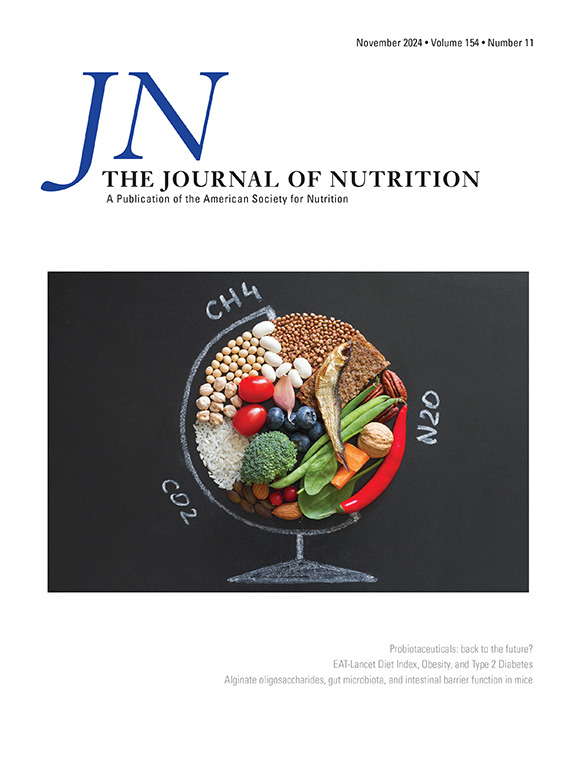猪真回肠氨基酸消化率系数的重复性:实验室间和实验室内。
IF 3.7
3区 医学
Q2 NUTRITION & DIETETICS
引用次数: 0
摘要
背景:在测定生长猪的真正回肠氨基酸(AA)消化率值以计算可消化的必需氨基酸评分(DIAAS)时,在遗传和环境方面,各实验室的方案各不相同。目的:在三个实验室(大洋洲、欧洲和北美)分别测定9种食物的回肠AA消化率,以确定实验室间的差异。在每个实验室,还对三种食物进行了两次评估,以确定实验室内的差异。方法:各实验室采用标准化方案测定每种食物的回肠AA真消化率。生长猪饲喂每种食物7 d,第6天和第7天在回肠末端通过套管收集食糜。在每个实验室测定每种食物的回肠AA消化率系数,以评估实验室间的差异。在每个实验室的不同猪群中对三种食物进行两次评估(实验室内变异)。结果:实验室对8种食物的回肠AA真消化率系数无显著影响(P < 0.05)。小麦面包的AA消化率存在差异。实验室间必需原子吸收剂消化率的平均变异系数(CV)为5.0%,所有原子吸收剂消化率的总体平均值为5.5%。对于实验室内变异,任何食物的AA消化率差异均无统计学意义(P>0.05), 3个实验室中每一种AA的平均cv分别为1.3、1.1和0.9%。结论:不同实验室对同一种食物测定的生长猪回肠AA真消化率(实验室间差异)差异不大。当同一种食物在同一实验室进行第二次评估时,消化率值几乎没有变化。本文章由计算机程序翻译,如有差异,请以英文原文为准。
Repeatability of Pig True Ileal Amino Acid Digestibility Coefficients: Among and Within Laboratories
Background
When determining true ileal amino acid (AA) digestibility values in the growing pig to calculate digestible indispensable AA score, there are aspects of the protocol, both genetic and environmental, that vary between laboratories.
Objectives
This study aimed to determine true ileal AA digestibility in 9 foods in each of 3 laboratories (Australasia, Europe, and North America) to determine interlaboratory variability. In each laboratory, 3 foods were also evaluated twice to determine intralaboratory variation.
Methods
Each laboratory followed a standardized protocol to determine true ileal AA digestibility for each food. Growing pigs received each food for 7 d and digesta were collected via a cannula at the terminal ileum on days 6 and 7. True ileal AA digestibility coefficients were determined for each food at each laboratory to evaluate interlaboratory variability. Three foods were evaluated twice in different cohorts of pigs at each laboratory (intralaboratory variation).
Results
There was no statistically significant effect (P > 0.05) of the laboratory on the true ileal AA digestibility coefficients for 8 of the foods. Differences in AA digestibility were found for wheat bread. The mean coefficient of variation (CV) between laboratories for digestibility of the indispensable AAs was 5.0% with an overall mean for all AAs of 5.5%. For intralaboratory variability, there were no statistically significant differences (P > 0.05) in AA digestibility for any food with mean CVs for each AA within each of the 3 laboratories for the indispensable AAs of 1.3%, 1.1%, and 0.9%.
Conclusions
True ileal AA digestibility values determined in the growing pig for the same foods in different laboratories (interlaboratory variation) do not vary greatly. When a single food was evaluated a second time in the same laboratory, little variation among digestibility values was found.
求助全文
通过发布文献求助,成功后即可免费获取论文全文。
去求助
来源期刊

Journal of Nutrition
医学-营养学
CiteScore
7.60
自引率
4.80%
发文量
260
审稿时长
39 days
期刊介绍:
The Journal of Nutrition (JN/J Nutr) publishes peer-reviewed original research papers covering all aspects of experimental nutrition in humans and other animal species; special articles such as reviews and biographies of prominent nutrition scientists; and issues, opinions, and commentaries on controversial issues in nutrition. Supplements are frequently published to provide extended discussion of topics of special interest.
 求助内容:
求助内容: 应助结果提醒方式:
应助结果提醒方式:


